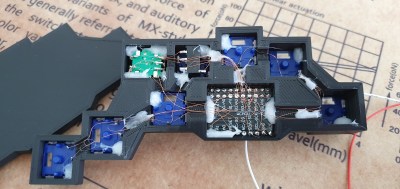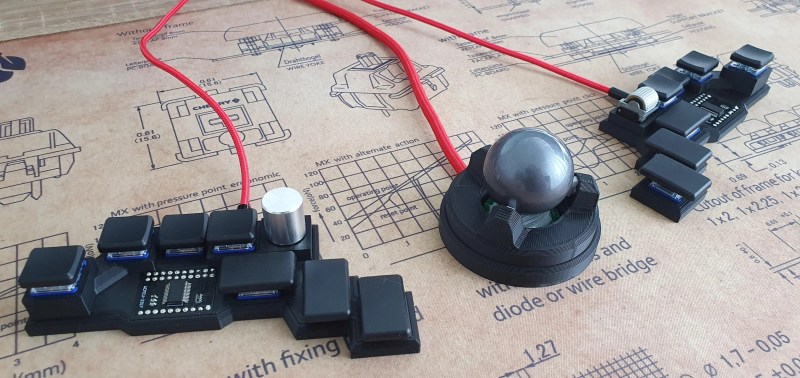What is the fastest way to get thoughts out of your brain and into relative permanence? Well, yeah, probably a voice recorder. But after voice recorders comes typing in a distant second. Typing, especially QWERTY-style, has its limitations. The holy grail method it comes to typing quickly has got to be a chording keyboard, hands down. How can court reporters possibly keep up with everything that’s uttered during a trial? When you can press a few keys at the same time and type entire words, it’s not that difficult. It just takes a whole lot of memorization and muscle memory to get to that point.
 So if you’re going to go for the glory, check out Chordie, a snazzy little chording keyboard that does it all with just 14 keys. [kbjunky] based Chordie on the Ginny, a cute little bare-bones bat-wing chording keyboard that uses the ASETNIOP chording engine originally built for soft keyboards.[kbjunky] added open-face trackball support via printed cradle, but it’s not necessary to use a trackball since there’s a pair of rotary encoders and a mouse layer.
So if you’re going to go for the glory, check out Chordie, a snazzy little chording keyboard that does it all with just 14 keys. [kbjunky] based Chordie on the Ginny, a cute little bare-bones bat-wing chording keyboard that uses the ASETNIOP chording engine originally built for soft keyboards.[kbjunky] added open-face trackball support via printed cradle, but it’s not necessary to use a trackball since there’s a pair of rotary encoders and a mouse layer.
This keyboard looks fantastic with its rocket ship MCU holder and its flush-mounted I/O expander breakout boards. Apparently [kbjunky] used polyimide tape to keep the solder from making blobs. It’s all there in the nice build guide.
We would probably argue that chording is not totally ergonomic. Sure, you barely move your hands or wrists, but chording itself can be hard on the digits, especially the pinkies. To that end, [kbjunky] used low-profile switches with light springs. Totally ergonomic or not, we have to admit that we love the idea of clacking along at 300 WPM someday far, far down the learning curve of ASETNIOP. Take a look at the key map, and check out [kbjunky]’s follow-up post if you want to see a demo.
Maybe you prefer a completely different typing experience. Well, ASETNIOP works with digital pianos, too.
















Cool keyboard! Love the split trackball design. Minor quibble with the article: ASETNIOP keyboards and other chorded keyboards that output a single character per chord are generally slower than traditional keyboards, not faster.
If you imagine the process of pressing and releasing a single key or chord of keys to take the same amount of time, then you’d expect typing to be the same speed between the two types. However, with regular keyboards, some additional speed is gained by pressing the next key while the first key is still held down, thus not changing the period of any key press, but still fitting in more key presses per unit of time. Single character chorded keyboards do not have this advantage, they only have the speed advantage of not having to more your fingers around as much — which may not be the main bottleneck. I’ve built several chorded keyboards in my life, but have dropped every single-character-chord scheme within them due to the hugely limited typing speed they gave me (plateauing at 25wpm vs. an easy 60wpm on a qwerty).
Stenography has significant gains as a chorded system because it maps multiple output characters per keypress. I haven’t been able to do this analysis in any great detail, but from a quick estimate, it looks like you might actually be pressing more keys per word in Plover-Steno than with a regular keyboard. However, you press them all at the same time, eliminating a lot of the key-press sequence time. There’s a lot more memorisation involved in Stenography than in ASETNIOP, due to having to learn an entirely new ‘spelling’ (fingering) per word vs. the regular english spelling.
I’m working on a keyboard that has some of the advantages of single-character chording (low finger movement, low button count vs. character output range, low memorisation, one to one map between key press and character output, etc), and some of the advantages of stenography (multiple characters output per chord group, expansions), at the expense of an overwhelming complexity in finger dexterity and necessary range of motion.
If anyone else has some thoughts about making a chorded keyboard with low memorisation but high character output per stroke, please let me know!
There are so many tiny details that change how fast you type with either – like how far your fingers have to move to reach the next key on a traditional keyboard, which is where chording should be able to go faster, how deep the keys travel is, which can probably be massively smaller for chording as your fingers never move you don’t need any travel at all to feel you are on only the right key. So with some optimising of the design I expect the keyboard of either sort isn’t what holds you back.
Ultimately I think most folks never get at all fast with a chording keyboard just because its not natural to them, so takes much longer to learn to that same level – anybody alive today has grown up seeing typewriters/typesetters/computers where every button does exactly one function, and its what we see in almost all human designed tools press button and only its stuff happens. The combination multi-button at once approach is just not what we ever tend to experience, not what we are self training for just by growing up in our environment – even the musicians using many keys at once on any keyed instrument probably the most similar to chording keyboards don’t generally have the same experience as each key still does just one thing, makes one sound in most instruments – something like a trumpet is close though.
Very difficult one to really just speed up – with predictive text type models you can get much faster output at the expense of precision, probably good enough for most folks, but a nightmare for anybody that has to deal with professional grammar and punctuation, CamelFormat or anything cases sensitive at all I guess…
Greetings! ASETNIOP designer Zack Dennis here. While I’d love to claim that ASETNIOP’s top range is higher than a keyboards, that’s probably not going to be the case. I type at about 110 wpm or so on a traditional QWERTY keyboard and my cruising speed on ASETNIOP is now in the low 90’s and hasn’t gotten any higher over the last year or so. A big part of that is because you’re using more keystrokes – only 38% of typed characters are chords which is pretty good (and the stenographic combinations help), but there’s no way around it when you limit things to ten input points. Another factor is that ASETNIOP isn’t really meant to complete with a traditional keyboard, which is designed specifically to make typing as fast as possible – it’s kind of like asking a human to complete in a swimming race against a fish. What it’s really about is opening up the world of possibilities for new interfaces – like the Chordie above – without sacrificing too much in terms of efficiency.
Personally I think that seems quite impressive, from what I’ve seen and read most folks never get even remotely close to the keyboard they grew up with with any extra chording. Possibly even more so as looking at your chording choice I’m not at all convinced by it, don’t get me wrong it looks perfectly useable, and maybe it really is great I don’t have enough experience to really judge. For myself I would I think rather keep it simpler and worry less about speed anyway – sure I type fast on qwerty, depending on the keyboard (and complexity of spellings/if copy typing) much faster than you to just a little faster. But that only matters (within reason) when you really know exactly what you are going to type, and are for some reason in a blazing hurry… Loosing a few words of min really doesn’t hurt, if anything it helps – forcing you to spend a little more time thinking on each phrase, even when copy typing if the keyboard is all wrong (like say not 100% scale) so you can’t go as fast as you would – suddenly you notice all the little errors because you end up taking so much extra time you actually process what you are copying (and that is as a Dyslexic, so no master of spelling and grammar – at least without that wonderful invention spell check).
I’d argue the normal keyboard has nothing to do with typing as fast as possible though, they layout is even famously arranged to ‘slow typing’ to avoid jams so the typing could end up faster overall… It just is fast because its what you really know how to do, and follows the patterns we train ourselves for daily…
In much the same way shorthand is really really slow to use if you don’t go and make it a professional requirement – part of your daily life, do it enough and illogical and clunky as it seems to the uninitiated it becomes efficient and very very fast (or at least so I’m told, and seems to be correct – as far as the uninitiated like myself to whom it might as well be written in Sumerian can tell). Same thing with Morse really – anything that doesn’t really get enough training time is always slower than the stuff you just do automatically through a lifetime of practice, the master at that are so fast I have no idea how they manage it, though yes in that case the input methodology is clearly not going to get you up to a good word rate – the point is practice turns barely making a few letters a min into holding conversations in reasonably normal timescales, positively hasty for an Ent at least…
When I was younger, I often pined for a chorded keyboard; however, after some time thinking about it, I realized that the keyboard I use already *is* chorded, although we don’t think about it as such, because lowercase letters are single key for single letters.
However, if I want to enter upper-case characters, I push a shift key. If I’m in Emacs and I want to save, I press C-x C-s; if I’m in Vim and I want to change panes, I press C-W k; if I’m in TMux and I want to switch windows, I press C-b o.
If I’m feeling daring, I can even map characters that, such as “jk”, if pressed together at the same time, will do something for me.
If all we ever entered into a keyboard were single-case letters, chording would be sensible, but we do much more with our keyboards than just that!
nice trackball.
I don’t know about the voice recorder, I feel like I can type faster than I can think already, so further improvements to speed don’t really improve the overall performance.
Chordie McChordface.
I like the track ball and scroll wheels.
Looks like I’ll be spending a lot of time in r/ErgoMechKeyboards
I just realized that “ASETNIOP” spelled backward is “POINTESA” and that just rolls off the tongue better, so I’m sticking with that 😄
That’s what I named my LLC!
The standard keyboard is the all time worst polyphonic design ever being the result of historic accident, so ANY other arrangement is better
This keyboard allows very great ease when handling chords
https://www.youtube.com/watch?v=SU2JztST_TY&t=1071s